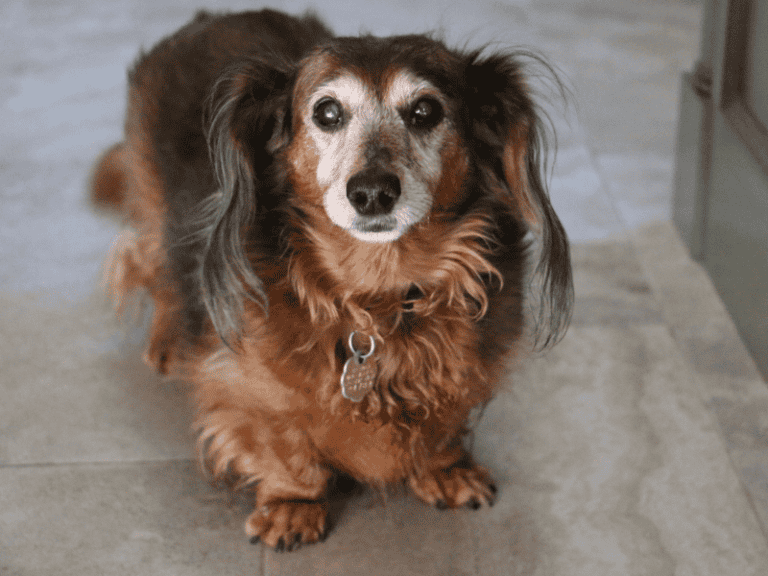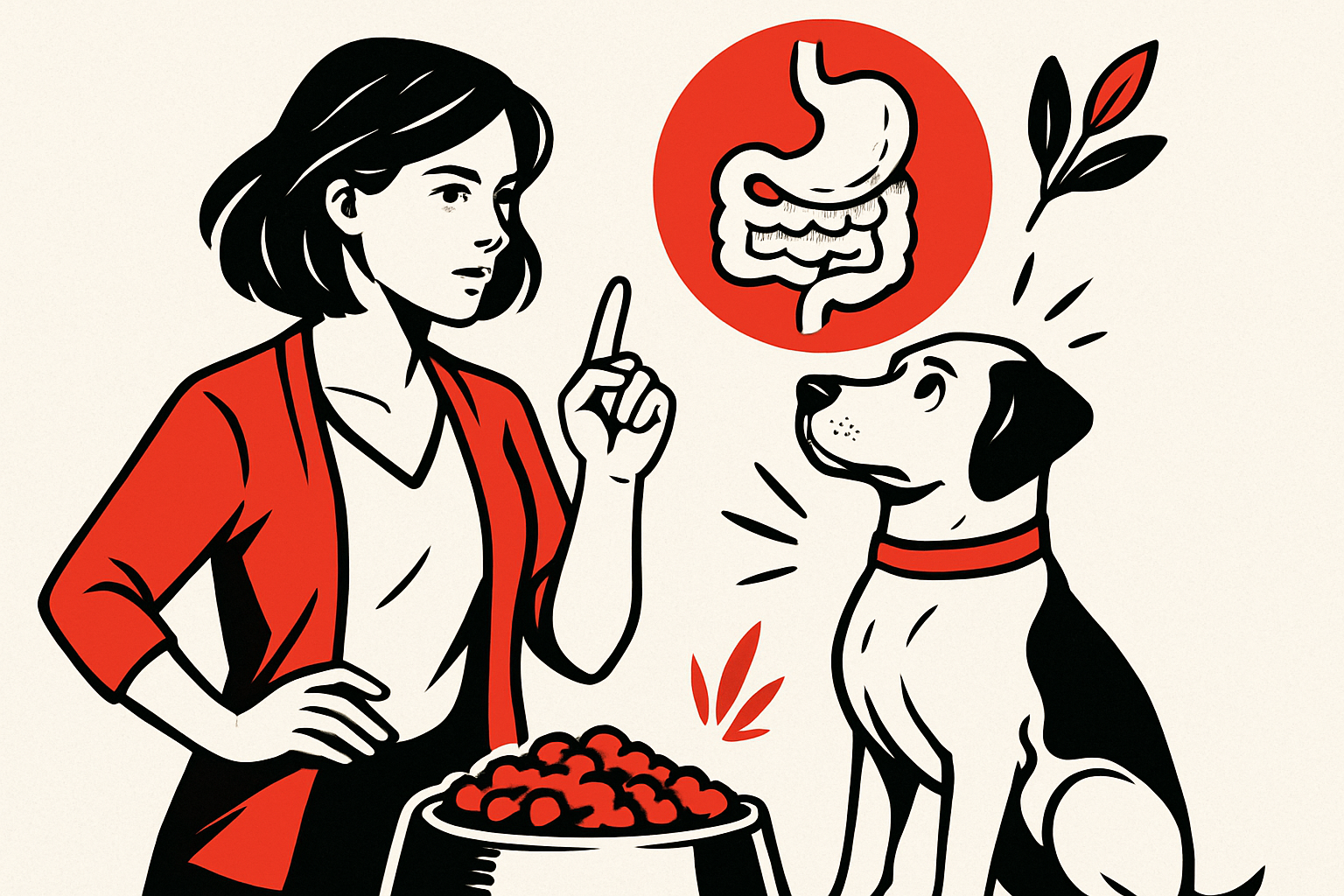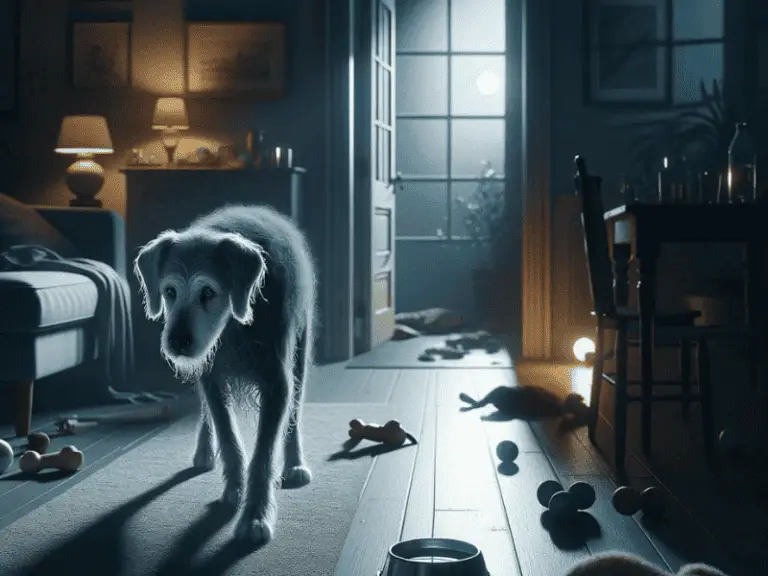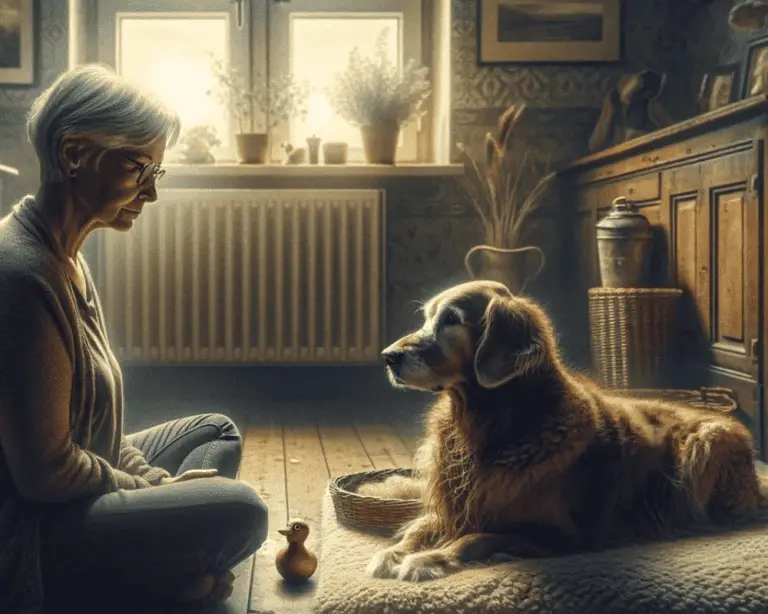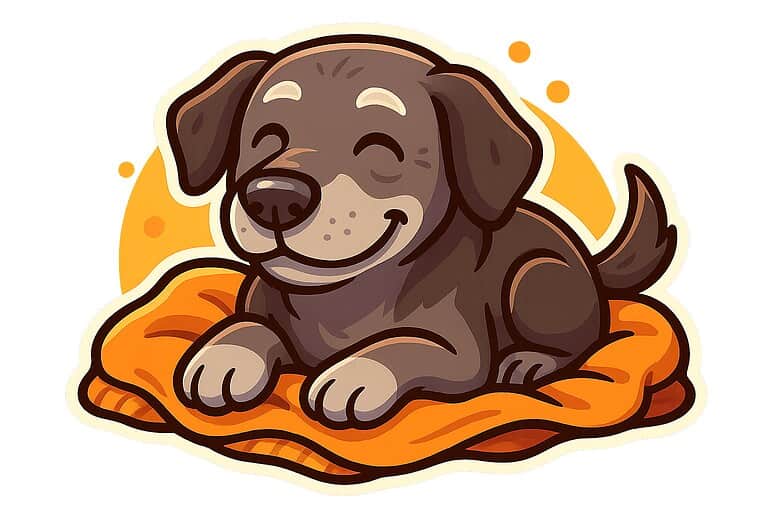How to check your senior dog’s stress level
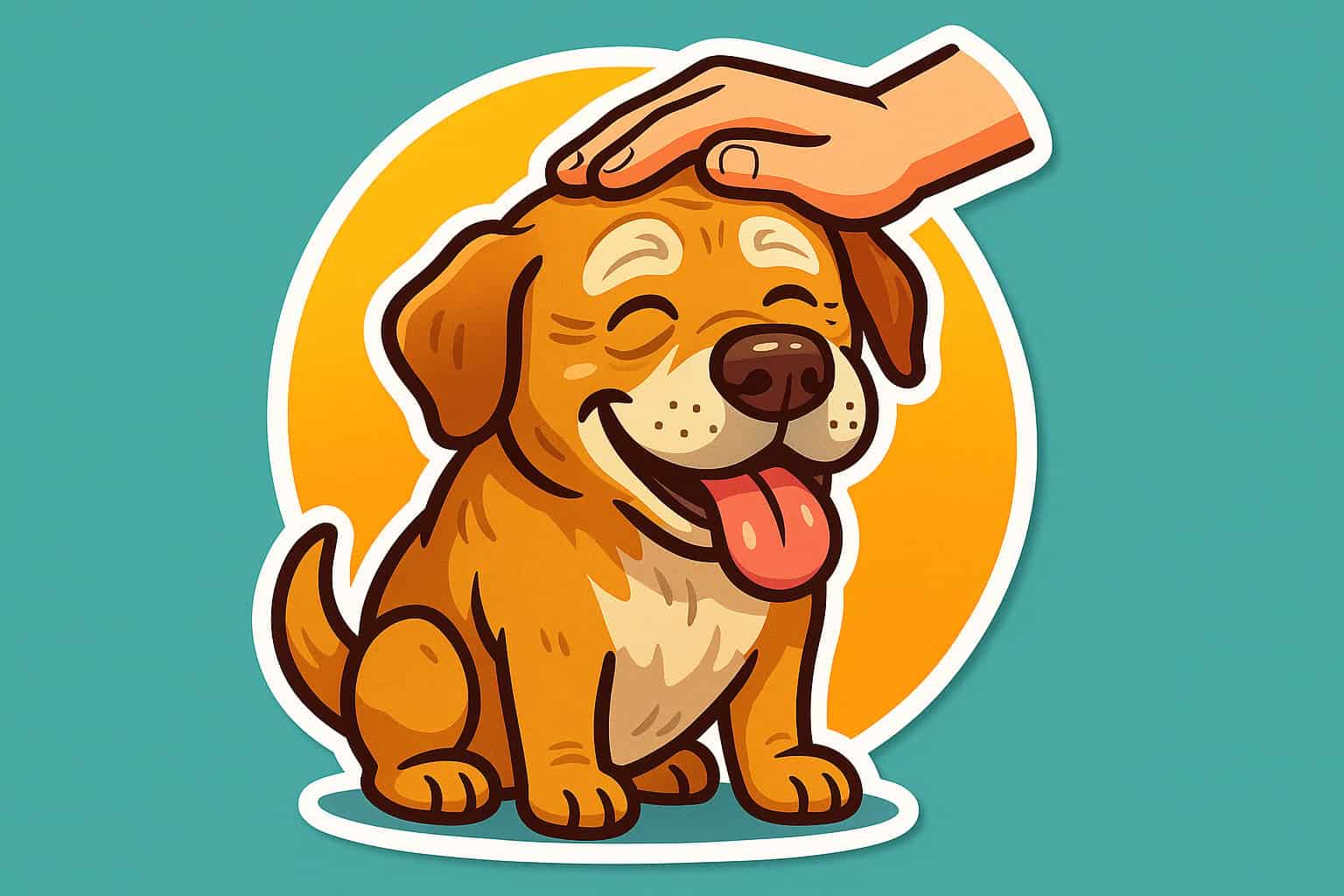
Watching your senior dog navigate their golden years can feel like a delicate balancing act. Maybe you’ve noticed your once-confident companion seems more restless during thunderstorms.
Or they’re suddenly clingy when you grab your car keys. You can check your senior dog’s stress level by observing changes in their behavior, body language, and daily routines, then using simple at-home assessments to gauge their comfort.
Just like us, dogs get more anxious as they age. Their world might feel less predictable when their hearing dims or their joints ache.
What used to be a minor inconvenience, like the neighbor’s lawn mower, might now feel overwhelming to your faithful friend.
You don’t need a veterinary degree to get good at reading your dog’s stress signals. If you learn to spot the subtle signs and pick up a few simple techniques, you can really help your senior pup feel more secure in daily life.
Understand Stress in Senior Dogs
Senior dogs experience stress differently than younger dogs. Aging brings unique challenges that can make them feel overwhelmed or anxious.
Physical changes, cognitive decline, and increased sensitivity to their environment all play a role in how stress affects your older companion.
What Is Stress in Older Dogs?
Stress in senior dogs is your pet’s response to situations that make them feel uncomfortable or threatened. Just like you might feel stressed when facing something new or challenging, your older dog experiences similar feelings.
When your senior dog feels stressed, their body releases hormones that get them ready for action. This worked well when they were younger and more adaptable.
Now, their aging body and mind struggle to keep up with these changes. You might notice your dog panting when it’s not hot, pacing around the house, or hiding in strange spots.
Some dogs become clingy and follow you everywhere, while others withdraw and avoid interaction.
Physical signs of stress include:
Heavy panting or drooling
Shaking or trembling
Loss of appetite
Changes in bathroom habits
Excessive shedding
Behavioral changes often show up as:
Restlessness or inability to settle
Whining or increased vocalization
Destructive behavior
Changes in sleep patterns
Why Senior Dogs Are More Prone to Stress
Your senior dog’s brain and body work differently now than they did in their younger years. It’s a bit like an old smartphone that doesn’t run as smoothly as it used to.
Cognitive changes affect how your dog processes information. They might feel confused about familiar routines or forget where their food bowl is.
This confusion creates stress because they can’t understand what’s happening around them. Physical limitations make everyday activities harder.
Your dog might struggle to climb stairs they used to bound up easily. When their body doesn’t respond the way they expect, it creates anxiety and frustration.
Sensory losses change how your dog experiences the world. If they can’t see or hear as well, sudden movements or sounds can startle them more easily.
They might not recognize you approaching from their blind side. Their immune system also weakens with age, making them feel more vulnerable.
Pain from arthritis or other health issues creates constant low-level stress that affects their mood and behavior.
Common Triggers for Stress in Senior Dogs
Your senior dog might react strongly to situations that never bothered them before. Knowing these triggers helps you create a calmer environment for them.
Environmental changes top the list of stress triggers. Moving furniture, new people in the house, or even different walking routes can upset your older dog.
They prefer predictability and routine. Loud noises become more frightening as dogs age.
Thunderstorms, fireworks, or construction sounds might send your previously calm dog into a panic. Their hearing changes can make these sounds seem more intense or confusing.
Separation anxiety often develops or worsens in senior dogs. They might follow you constantly or become distressed when you leave.
This happens because they feel more vulnerable and need your reassurance. Medical procedures and vet visits create significant stress.
Your dog might sense something is different about their body but can’t understand why they feel uncomfortable. Social situations with other dogs or unfamiliar people can overwhelm senior dogs.
They might not have the energy or patience they once had for social interactions.
Recognize Signs of Stress in Your Senior Dog
Stress shows up differently in older dogs than younger ones. Your aging companion might display physical symptoms, changes in behavior, different ways of communicating, or shifts in their eating and sleeping habits.
Physical Symptoms to Watch For
Panting and breathing changes are often the first signs you’ll notice. Does your senior dog pant when it’s not hot or after exercise?
Heavy breathing during rest can signal stress or discomfort. Trembling or shaking becomes more common as dogs age.
You might see subtle shakes in their legs or whole-body tremors during stressful situations. Watch for digestive issues like:
Diarrhea or loose stools
Vomiting without clear cause
Loss of bladder control
Excessive drooling
Physical tension shows up in tight muscles and stiff posture. Your dog might hold their tail low or tucked under.
Their ears may stay pinned back against their head. Excessive grooming can indicate stress.
Some senior dogs lick their paws or legs until they’re raw. Others might suddenly stop grooming altogether, leading to a dull or matted coat.
Changes in heart rate during calm moments can also signal stress, though you’ll need your vet to check this properly.
Behavioral Changes in Senior Dogs
Restlessness often appears first. Your once-calm senior might pace around the house or seem unable to settle in their favorite spot.
They may get up and lie down repeatedly. Hiding behavior is common in stressed older dogs.
Maybe your social pup now retreats under beds or behind furniture. Some dogs seek out dark, quiet spaces they never used before.
Aggression or irritability can develop suddenly. Your gentle senior might snap at other pets or growl when touched.
This behavior often stems from pain or confusion rather than true aggression. Destructive actions look different in senior dogs.
Instead of chewing shoes, they might scratch at doors or dig at carpets. Some older dogs start having accidents in the house after years of perfect house training.
Clingy behavior increases with age and stress. Your independent dog might follow you everywhere or whine when you leave the room, even briefly.
Unusual Vocalizations and Communication
Excessive barking often changes in senior dogs. Your quiet dog might start barking at nothing.
Or your vocal dog might bark more urgently than before. Whining and whimpering become more frequent.
You might hear soft whines during normal activities like walking or lying down. Night-time whimpering is especially common in stressed senior dogs.
Howling can start suddenly in older dogs. Some seniors howl when left alone, while others howl at specific times of day for no clear reason.
Changes in their „talking“ patterns matter too. Dogs who used to greet you with happy sounds might become silent.
Others might develop new vocal habits like constant mumbling or grumbling. Pay attention to when these sounds happen.
Vocalizations during storms, at night, or when you’re preparing to leave often indicate stress rather than physical pain.
Changes in Appetite and Sleep Patterns
Eating changes show up in different ways. Your dog might eat much less than usual or become a picky eater.
Some stressed seniors eat too quickly or seem anxious around their food bowl. Water consumption changes matter too.
Drinking much more or much less than normal can signal stress or underlying health issues that cause stress. Sleep disruption is very common in senior dogs.
Your dog might sleep more during the day but pace at night. Others have trouble falling asleep or wake up frequently.
Location preferences for sleeping often change. Your bed-loving dog might suddenly prefer the floor.
Or your independent sleeper might want to be near you all night. Eating schedule disruptions can indicate stress.
Dogs who used to eat on schedule might lose interest in meal times or beg for food at unusual hours.
How to Check Your Senior Dog’s Stress Level at Home
You can learn to spot stress signs in your older dog by watching their daily habits and behavior changes. Simple tests and keeping a daily record will help you track patterns and know when professional help is needed.
Simple Observation Techniques
Your senior dog shows stress through body language and behavior changes. Watch for these key signs during regular activities.
Physical signs include panting when it’s not hot, drooling more than usual, or shaking without being cold. Does your dog seem restless or pace around the house?
These are clear stress signals. Behavioral changes often show up first.
Maybe you’ve noticed your dog hiding in unusual spots or following you everywhere. Some dogs become clingy while others withdraw completely.
Look at their eating habits too. Stressed senior dogs might skip meals or eat much less than normal.
Sleep patterns change as well. Your dog might wake up more at night or sleep much more during the day.
Eye and ear signals tell you a lot. Wide eyes showing white parts or ears pinned back against their head mean your dog feels anxious.
Yawning when not tired is another stress sign many people miss. Watch how your dog reacts to normal daily events.
Do they seem scared of things that never bothered them before? This could mean stress or pain is making them more sensitive.
Easy At-Home Stress Tests
Try these simple tests to check your dog’s comfort level in everyday situations. The doorbell test shows how your dog handles sudden sounds.
Ring the doorbell or knock on the door. A calm dog might look up or walk to the door.
A stressed dog will pant heavily, shake, or hide. The treat test reveals appetite and focus issues.
Offer your dog’s favorite treat during a calm moment. If they ignore it or seem uninterested, this might signal stress or health problems.
The touch test helps you find sore spots that cause stress. Gently pet your dog from head to tail.
Watch for pulling away, growling, or tense muscles. Senior dogs often develop arthritis that makes touching painful.
The separation test checks anxiety when you leave. Put on your coat and pick up your keys like you’re leaving.
Does your dog pace, whine, or follow you around? This shows separation stress.
Try the noise test with everyday sounds. Drop a book or turn on the vacuum cleaner.
Note how long it takes your dog to calm down after the sound stops.
Use a Daily Journal to Track Stress
A simple journal helps you spot stress patterns and triggers you might otherwise miss. Write down three things each day: your dog’s mood, appetite, and sleep quality.
Use a scale of 1 to 5, where 1 means very stressed and 5 means completely calm. Track specific behaviors like panting, pacing, or hiding.
Note what time these happen and what was going on around your dog. You might find patterns linked to certain times or activities.
Record appetite changes by noting if your dog finished their meals. Mark down any treats they refused or times they seemed uninterested in food.
Sleep tracking matters too. Write down if your dog had trouble settling at night or woke up often.
Note any changes in their favorite sleeping spots. Include trigger events in your notes.
Did construction noise outside make your dog anxious? Did visitors stress them out?
These details help you prepare for future situations. Review your journal weekly to spot trends.
Maybe your dog gets more stressed on busy days or during certain weather. This information helps you make better choices for your pet.
When to Seek Professional Help
Some stress signs need a vet’s attention right away, especially in senior dogs where stress often links to health problems. Call your vet immediately if your dog stops eating for more than 24 hours, has trouble breathing, or shows signs of pain like whimpering or reluctance to move.
Schedule an appointment soon if stress behaviors last more than a week despite your efforts to help. This includes ongoing panting, pacing, or sleep problems that don’t improve.
Physical symptoms like vomiting, diarrhea, or excessive drooling along with stress behaviors need professional evaluation. Senior dogs can develop medical conditions that cause both pain and anxiety.
Severe behavioral changes require expert help. If your normally friendly dog becomes aggressive or your social dog completely withdraws, something serious might be wrong.
Medication might help in cases where natural calming methods don’t work. Your vet can prescribe safe anti-anxiety medications designed for older dogs.
If you have two dogs and only one seems stressed, bring both to the vet appointment. Sometimes the calm dog’s presence helps the stressed one during the exam.
Practical Tips for Reducing Stress in Senior Dogs
Reducing stress in your older dog involves creating a peaceful home setting, making small changes to daily routines, providing gentle movement, and using comfort techniques. These simple steps can make a big difference in how relaxed and happy your senior dog feels every day.
Creating a Calm Home Environment
Your senior dog needs a quiet, safe space where they can rest without worry. Think of it like creating a cozy bedroom just for them.
Choose the right sleeping spot. Place their bed away from high-traffic areas like hallways or the kitchen. A corner of the living room or a quiet bedroom works well.
Your dog should be able to see what’s happening but not be in the middle of all the action. Keep noise levels down.
Loud TVs, music, or sudden sounds can startle older dogs more than younger ones. If you have kids running around, teach them to be quieter near your dog’s resting area.
Use soft lighting. Bright overhead lights can feel harsh. Try using lamps or natural light from windows instead.
This creates a more relaxing atmosphere for your senior pup. Make sure the temperature is comfortable.
Older dogs often feel cold more easily. Add extra blankets to their bed or move it away from drafty windows and doors.
Adjusting Routines for Older Dogs
A steady routine gives your senior dog a sense of what’s coming each day. This helps cut down on worry and confusion.
Stick to regular meal times. Feed your dog at the same times every day. If you usually feed at 7 AM and 5 PM, try to keep those times, even on weekends.
Create a bedtime routine. Maybe you brush them gently, then let them outside for a final bathroom break, and then they settle into bed. Do these steps in the same order each night so it feels familiar.
Keep vet visits predictable. Schedule check-ups for the same time of day if you can. If your dog stays calmer in the morning, book morning appointments.
Go slow with changes. If you need to move their food bowl, shift it halfway to the new spot for a few days first. Gradual adjustments help your dog feel less unsettled.
Exercise and Gentle Play
Older dogs still need movement, just not the same as when they were young.
Try short, frequent walks. Instead of a single long walk, break it up into three 10-minute strolls. It’s easier on their joints and less exhausting.
Let them set the pace. If your dog wants to stop and sniff every tree, let them. More rest breaks are totally normal now.
Use gentle play activities:
- Slow games of fetch with soft toys
- Puzzle toys stuffed with treats
- Short, easy training sessions
- Swimming, if they like water
Watch for signs they’re tired. Heavy panting, lying down mid-walk, or just wanting to turn back means it’s time to rest.
Soothing Techniques and Comfort Items
Sometimes older dogs need a little extra help to feel calm and safe.
Try calming touches. Gentle petting or a light massage can work wonders. Some dogs love ear rubs or a soft scratch on the chest.
Use comfort items:
- Weighted blankets made for dogs
- Calming music designed for pets
- Pheromone diffusers with relaxing scents
- Favorite toys from their younger days
Create positive associations. If your dog gets stressed during certain activities, pair them with something they like. Hand out treats during nail trims or play their favorite tunes before vet visits.
Stay calm yourself. Dogs read your mood like a book. If you’re anxious, they’ll feel it too. Take a breath and keep your voice soft and steady.
Getting Expert Help With Senior Dog Stress
Your vet can pinpoint medical reasons for stress. Behavioral experts offer training ideas and supplement advice to keep things safe.
Working With Your Veterinarian
Your vet should be your first stop when your senior dog seems stressed. They’ll check for health issues that could be causing anxiety.
A lot of stress in older dogs comes from pain or illness. Arthritis, vision loss, or hearing changes can make your dog uneasy.
Tell your vet exactly what you’ve noticed. Does your dog pace at night? Hide during storms? Pant for no clear reason? The more details you give, the better.
Your vet may suggest blood tests to check for thyroid or other health problems. These are common in older dogs and can mimic anxiety.
If your dog takes several medications, bring a list. Some meds don’t mix well with anti-anxiety treatments.
Ask your vet about:
- Pain management options
- Safe anti-anxiety meds for seniors
- Dietary tweaks that could help
- Physical therapy or gentle exercise plans
Consulting a Canine Behaviorist
Sometimes you need a specialist for stress problems. A certified dog behaviorist can build a plan tailored to your senior dog’s needs.
Behaviorists focus on changing how your dog feels, not just teaching commands. Their approach is different from standard dog trainers.
Find someone who’s worked with older dogs before. Seniors learn differently than puppies and need a softer touch.
A good behaviorist usually visits your home first. They want to see where the stress happens and get to know your dog’s routine.
What to expect during sessions:
- Assessment of your dog’s triggers
- Step-by-step training plans
- Practice sessions with you
- Ongoing support and tweaks
Progress can be slow. Most older dogs need weeks or even months to really improve.
Choosing Calming Supplements Safely
Plenty of natural supplements claim to help stressed senior dogs. But you’ve got to be careful and talk to your vet first.
Never start supplements without your vet’s okay. Older dogs often take other meds, and some combinations can be risky.
Popular calming supplements include:
| Supplement | How It Helps | Safety Notes |
|---|---|---|
| Melatonin | Promotes sleep and calm | Use dog-safe doses only |
| L-theanine | Naturally eases anxiety | Very safe in most cases |
| Chamomile | Mild relaxation effects | Can cause allergies in some dogs |
| CBD products | May ease stress and pain | Check laws and vet approval |
Try only one supplement at a time. That way, you’ll know what’s working and can catch side effects fast.
Quality really matters. Pick products made just for dogs from brands you trust. Human versions sometimes contain things that are toxic to pets.
Supplements aren’t instant fixes. Most take 2-4 weeks of daily use before you’ll notice a difference.
Prevent Stress in Your Senior Dog’s Daily Life
A calm environment helps your older dog feel safe. Planning ahead and keeping things predictable can make a huge difference.
Planning Stress-Free Outings
Older dogs still need fresh air and stimulation, but their walks need more thought. Go out during quieter times when there’s less noise and fewer dogs.
Pick routes with soft ground like grass or dirt. Hard pavement can be tough on stiff joints.
Keep these items handy for outings:
- Portable water bowl and fresh water
- Comfy harness instead of a collar
- Non-slip booties for slick surfaces
- Blanket for rest breaks
Pay attention to your dog’s body language. If they start panting hard or lagging, it’s time for a break or to head home.
Weather matters more now. Seniors get cold faster and can overheat easily.
If your dog gets overwhelmed at busy parks, try going during off-peak hours or find a quieter spot. Let them explore at their own pace.
Building a Predictable Routine
Older dogs find comfort in a steady schedule. It cuts down on anxiety and confusion as they age.
Feed your dog at the same times each day. This helps with digestion and gives them something to count on.
Daily routine essentials:
- Meals at consistent times morning and night
- Bathroom breaks every 4-6 hours
- Short walks or gentle play
- Quiet time for naps in their favorite spot
Keep their sleeping area in the same place. If you have two dogs, make sure each has their own cozy spot.
Stick to the same bedtime routine. Maybe a final potty break, a treat, or some gentle petting before bed.
If your dog seems confused about meals or bathroom breaks, try adding more structure instead of less.
Introducing Changes Gradually
Sometimes you can’t avoid change, but how you handle it really matters for your senior dog.
If you need to move furniture, do it piece by piece over several days. That gives your dog time to get used to each change.
Introduce new family members or pets slowly. Let your dog meet them on neutral ground first, then bring them into the house bit by bit.
Steps for gradual change:
- Start with short, positive introductions
- Only increase time together if your dog seems relaxed
- Always let them retreat to their safe space if needed
- Reward calm behavior with treats or praise
Switch foods over 7-10 days, mixing in more of the new food each day.
Try practicing new routines during calm times. If you need to give medication, rehearse the motions with treats before the real thing.
Track Progress and Celebrate Small Wins
Keeping track of how your senior dog handles stress can reveal patterns you might miss otherwise. Every small win counts, and sharing progress can help other pet parents too.
Using Progress Charts or Checklists
A simple tracking system makes it easier to notice changes in your dog’s stress. Grab a notebook or make a chart on your phone.
Daily Stress Level Chart:
| Date | Morning Stress (1-5) | Triggers Noticed | Evening Stress (1-5) | Notes |
|---|---|---|---|---|
| Sept 1 | 3 | Loud noises | 2 | Calmer after walk |
| Sept 2 | 2 | None observed | 1 | Great day! |
Track things like panting, pacing, or hiding. Note what happened right before, was it a loud noise or a visitor?
Write down what soothes your dog. Maybe soft music helps, or a certain toy does the trick. Over time, these notes become really useful.
Check off small wins each day. Did your dog eat breakfast calmly? Mark it down. Did they enjoy their walk? That’s a win too.
Celebrating Your Dog’s Achievements
Every step forward deserves a little celebration, especially for older dogs. You don’t have to go big.
If your dog has a calm morning, give them extra gentle pets. When they try a new calming trick, offer some praise in a soft voice.
Snap photos of peaceful moments, your dog snoozing in their favorite spot, or enjoying a slow walk. These pictures remind you of progress on tougher days.
Choose rewards that fit your dog’s energy. Maybe it’s a special treat, a longer brushing session, or a short car ride. Keep things mellow so you don’t overwhelm them.
Progress isn’t a straight line. Some days will feel harder, and that’s just how it goes with senior dogs. Try to focus on the bigger picture, weekly improvements, not every single day.
Share Your Senior Dog’s Story
Connecting with other senior dog parents can really help. You might find support and encouragement you didn’t expect.
Your experiences could actually make a difference for someone else facing similar challenges. Sometimes, just knowing you’re not alone makes things easier.
Jump into online groups focused on senior dog care. Talk about which stress management tricks work for your dog.
Maybe your homemade calming space idea will inspire another worried pet parent. Sometimes the simplest things help the most.
Chat with your friends and family about your dog’s journey. They might notice improvements you miss since you see your dog every day.
Think about starting a blog or a social media account for your dog’s story. Post about the good days and the tough ones too.
Other pet parents often find comfort in these honest updates. It’s nice to know you’re part of a community.
Your veterinarian wants to hear about what works at home. Bring your tracking notes to appointments.
Sharing this info helps your vet understand your dog’s stress patterns a bit better. Sometimes those little details make all the difference.

